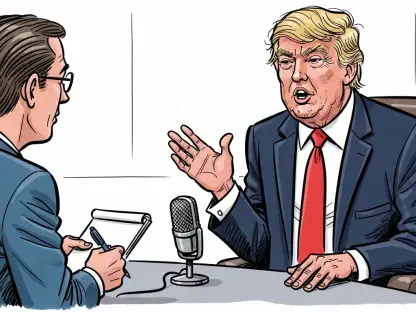Amid contentious debates and political maneuvering, the Trump administration rolled out a comprehensive fiscal agenda seeking to institute massive changes through cuts in federal spending, tax revisions, and a shift toward deregulation. At the core of this agenda lies an effort to align various congressional committees, notably the House Ways and Means, Energy and Commerce, and Agriculture committees, around a multitrillion-dollar tax and spending policy. These fundamental changes herald a new era of fiscal conservatism with the aim of nurturing economic growth, yet they pose significant challenges, such as potential reductions in social welfare. The agenda calls for a drastic restructuring in vital areas like healthcare and environmental policy, ostensibly to prioritize national security and facilitate economic revitalization. These initiatives are framed under Trump’s ‘America First’ vision but have sparked heated discussions regarding their broader implications for everyday American life.
Revamping Congressional Priorities
Integral to the Trump administration’s vision is the pressing objective of realigning budgetary priorities to accommodate planned tax cuts. This effort involves major cutbacks in government spending, setting substantial fiscal goals for pivotal House committees. The Ways and Means Committee, spearheaded by Chairman Jason Smith, plays a crucial role in advancing the legislation. This aligns with Trump’s promise to reward hard work, create jobs, and bolster the working class. Yet, amid fulfilling military spending and economic priorities, notable apprehensions surface, particularly concerning the potential social impact of diminished healthcare access and increased financial pressure on lower-income segments of the population. The agenda proposes significant restructuring of Medicaid and food stamp programs aimed at introducing stringent work requirements, coupled with enhanced eligibility checks. This can lead to substantial cutbacks in social welfare, raising ongoing debates regarding the balance between minimizing government spending and ensuring that vulnerable populations receive support.
Rethinking Environmental and Energy Policies
A notable component of the agenda is the proposal to phase out environmental regulations and tax incentives for electric vehicles, marking a substantial shift in the national energy strategy. The House Energy and Commerce Committee has been pivotal in this effort. This rollback aligns with broader goals to reduce regulatory burdens, reflecting enhanced fiscal conservatism. Critics voice concerns about this shift, which appears to step back from proactive climate action. The proposed legislation seeks to eliminate stringent emission standards for vehicles—a regulation originally aimed at drastically increasing electric vehicle sales over the next decade. Advocates of the deregulation strategy, like EPA Administrator Lee Zeldin, argue that relaxing auto industry regulations harmonizes with consumer choice and economic productivity, potentially increasing federal revenue by boosting gasoline-powered vehicle consumption. These adjustments reflect the administration’s intent to recalibrate environmental policies, closely tying fiscal gains to deregulation in a landscape of budgetary constraints.
Implications and Future Outlook
This multifaceted legislative initiative encompasses significant changes to healthcare reform. Projected adjustments, anticipated to go into full effect by 2029, coincide strategically with potential shifts in political landscapes. The congressional proposal sees a potential $912 billion reduction in federal spending aimed primarily at Medicaid and the Affordable Care Act, ushering in an era of rigorous paperwork requirements and mandatory work hours for benefit retention. This, coupled with enforced co-payments, places increased pressure on recipients, who may face the risk of losing healthcare coverage due to non-compliance with government validation processes. Democrats, led by key figures like Rep. Frank Pallone and House Minority Leader Hakeem Jeffries, express staunch opposition, projecting severe consequences, including hospital closures, diminished access for seniors, and escalating premiums. The overarching fiscal agenda illustrates distinct divergence in political stance, revealing the administration’s tactical considerations amid constrained national resources.
Balancing National Needs
A key aspect of the Trump administration’s strategy is realigning budget priorities to accommodate planned tax reductions. This involves significant reductions in government spending, setting ambitious fiscal goals for pivotal House committees, especially the Ways and Means Committee, led by Chairman Jason Smith, which is instrumental in pushing this agenda forward. This strategy aligns with Trump’s promise to reward hard work, create jobs, and strengthen the working class. However, as military and economic priorities are emphasized, concerns arise about the social impact, particularly diminished healthcare access and increased financial strain on lower-income populations. The proposal includes major changes to Medicaid and food stamp programs, aiming to impose strict work requirements and bolster eligibility checks. Such measures could lead to significant reductions in social welfare, fueling ongoing debates about the balance between cutting government spending and ensuring vulnerable populations are supported.









